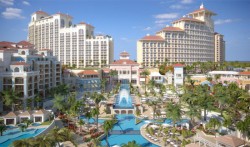Statistics from the MOT reveal that of the record five million tourists to visit the Bahamas in 2005, over three million of them were cruise visitors. But trends for 2006 so far suggest that numbers are falling off, which has led the MOT and it partners to seek ways to sustain the cruise tourism industry.
“The importance that we are trying to capitalise on is that we have an enormous opportunity here,” said Carla Stuart, Director of Cruise Development at the MOT. “A lot of our emphasis has been on helping the people that work in this area to come to a full understanding and appreciation that this might be our only opportunity to impress and get these tourists to come back as stopover visitors,” she added.
Over the last 35 years the trend in visitor arrivals has shifted dramatically. In the early 1970s over 60 percent of visitors to The Bahamas were air arrivals. Now, over 70 percent of the visitors come by sea. The impact has been on the amount of money visitors spend. On average, stopover visitors spend over $900 compared to the $73 spent by the cruise visitor. One of the MOT’s aims is to get cruise visitors to return as stopover visitors.
However, the cruise dollar is important Ms Stuart said, “because it goes directly into the hands of a taxi driver, a braider and the Bay Street merchants; so there is still really enormous employment through the cruise industry.”
But whether or not more cruise visitors return as stopovers depends heavily on the level of professionalism and hospitality of Bahamian merchants that interact with the tourists, Ms Stuart said.
More emphasis would also be placed on further developing Festival Place, the check-point for visitors leaving the cruise ship.
“Over the past two years there has been training for people working in this area,” she said. The most recent training session included hair braiders, port security, port authority administrators, and artisans, and the sessions focused on tourism trends, customer service, resolving conflicts and remaining motivated.
However, two merchants in the immediate port area that wished to remain anonymous said they understood the position of the MOT on what is expected of them. However, they feel not enough emphasis is being placed on their needs to help them to offer better service to cruise visitors.
But putting everything in place so that everyone benefits from cruise tourism is a process that will take time, Ms Stuart explained.
Further, the Nassau Tourism Development Board plans to capitalise on opportunities from cruise tourism. The Board has already begun the initial phases of redevelopment for the Downtown Nassau area which caters to hundreds of tourists daily. “The cruise industry has really kept Nassau together,” said Charles Klonaris, Chairman of the NTDB.
By: BARRY WILLIAMS, The Nassau Guardian



